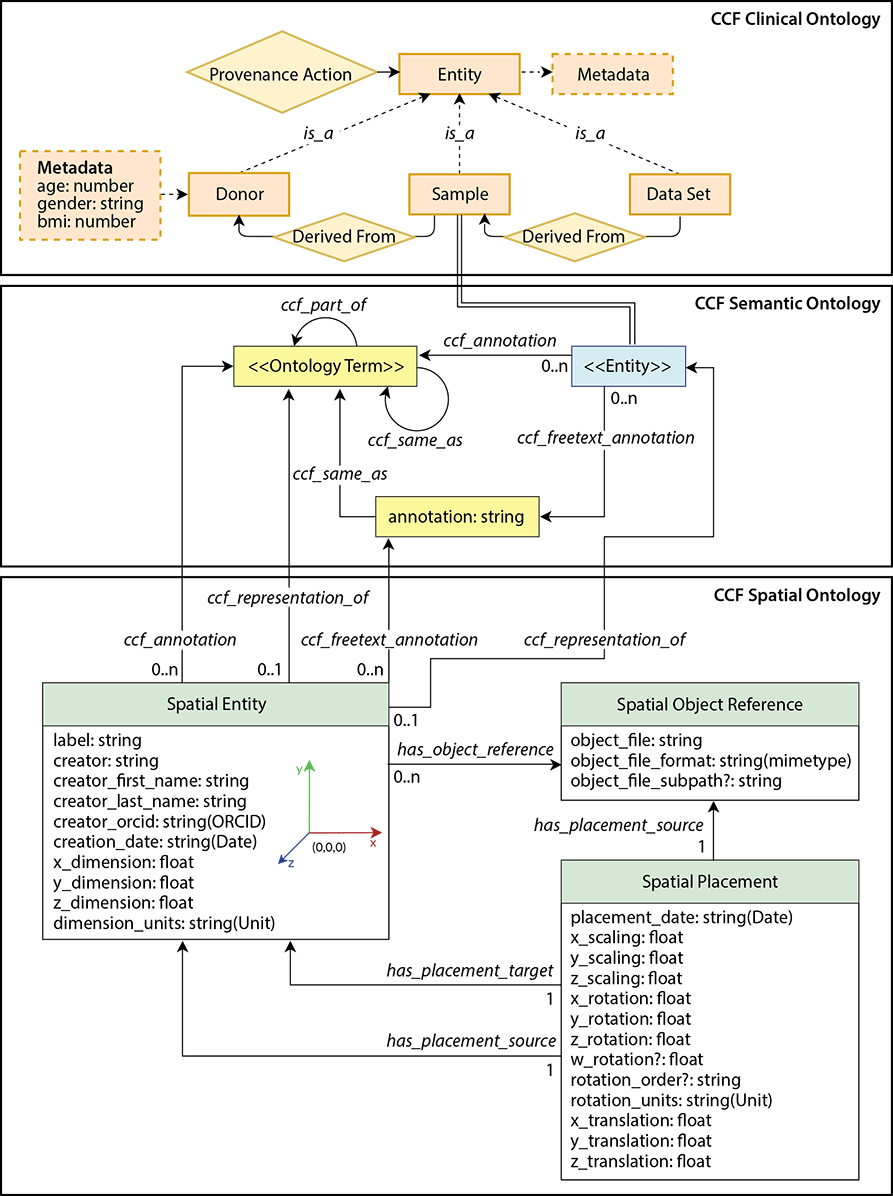ASCT+B Cell Types Data from Azimuth Reference Data With Summaries
Overview
ASCT+B tables represent cell by gene (CxG) relationships that are also captured in the HuBMAP Azimuth references. This site provides the cell type typology for all existing Azimuth annotated reference datasets; the Azimuth cell type typology trees can be visualized in the ASCT+B Reporter.
We also provide easy access to results for comparing CxG in ASCT+B vs. CxG in Azimuth. In Jan 2022, Azimuth supports single-cell RNA-seq data exclusively. As more experimental data becomes available and additional types of data are supported (e.g., proteins, lipids, metabolites), data differences will decrease.
Azimuth Cell Type Typologies and Counts
In Jan 2022, eight molecular reference maps for human are available via Azimuth. For each we provide the cell type typology as a file that can be visualized in the ASCT+B Reporter together with a table that lists the annotation level and the number of cell types for each unique cell in the organ-specific Azimuth reference, see Table 1.
Comparison of CxG in ASCT+B vs. Azimuth
Table 3 shows the comparison of the CxG matrix in ASCT+B tables vs. CxG matrix in Azimuth for each organ in Jan 2022. An automatically generated, up-to-date comparison is available here; this xls also contains separate sheets with cell types that are not (yet) covered in the ASCT+B tables. Details on how the comparison is calculated are on GitHub. Note that not all Azimuth cell types have CL IDs; in these cases, matching is done based on cell type names.
Data from https://github.com/satijalab/azimuth_website has been parsed to derive cell type typologies:
| Cell Types | Annotation Levels in Azimuth Reference | Total Cell Count in Aziumuth Reference | Biomarkers | ||||||||
|---|---|---|---|---|---|---|---|---|---|---|---|
| Azimuth | ASCT+B v1.0 | Matches | Azimuth | ASCT+B | Matches | ||||||
| Unique Names | Unique IDs | Unique Names | Unique IDs | Using IDs | Using labels | ||||||
| Bone Marrow & Blood | 72 | 32 | 46 | 16 | 5 | N/A | 3 | 35,355 | 352 | 199 | 87 |
| Brain | 187 | 10 | 127 | N/A | 123 | N/A | 4 | 24,402 | 864 | 254 | 152 |
| Heart | 24 | N/A | 17 | 18 | N/A | 6 | 2 | 656,509 | 216 | 48 | 25 |
| Kidney | 53 | 39 | 61 | 46 | 23 | N/A | 3 | 58,461 | 432 | 150 | 70 |
| Lung | 67 | 43 | 93 | 74 | 14 | N/A | 2 | 65,662 | 556 | 172 | 73 |
| Pancreas | 13 | 12 | 0 | 0 | 0 | N/A | 1 | 35,289 | 128 | 0 | 0 |
| Spleen | 49 | N/A | 66 | N/A | N/A | 4 | 9 | 5,104 | N/A | N/A | N/A |
| Lung v2 | 90 | N/A | 84 | 82 | N/A | 8 | 6 | 584,884 | 390 | 172 | 54 |
Code is available on GitHub.
Azimuth CT Counts
Data from https://github.com/satijalab/azimuth_website has been parsed to derive cell type counts:
Code is available on GitHub.
Code on Github
All code is freely available on GitHub.
Terms of Use
HuBMAP data are supplied with no warranties, expressed or implied, including without limitation, any warranty of merchantability or fitness for a particular purpose or non-infringement. No warranty with respect to the HuBMAP infrastructure is provided, including without limitation, any uptime warranty. The Parties make no representations that the use of the data will not infringe any patent or proprietary rights of third parties.
License
All CCF 3D reference objects are released under Attribution 4.0 International (CC BY 4.0).
Citation
If you use the data files v1.0 release, please cite this effort as follows:
Acknowledgements
This code and data was compiled by the HuBMAP MC-IU team in close collaboration with the MC-NYGC team.
References
- Börner, Katy, Sarah A Teichmann, Ellen M Quardokus, et al. 2021. "Anatomical structures, cell types and biomarkers of the Human Reference Atlas". Nature Cell Biology 23: 1117-1128. doi: 10.1038/s41556-021-00788-6.
- Hao Y, Hao S, Andersen-Nissen E, Mauck WM 3rd, Zheng S, Butler A, Lee MJ, Wilk AJ, Darby C, Zager M, Hoffman P, Stoeckius M, Papalexi E, Mimitou EP, Jain J, Srivastava A, Stuart T, Fleming LM, Yeung B, Rogers AJ, McElrath JM, Blish CA, Gottardo R, Smibert P, Satija R. 2021. "Integrated analysis of multimodal single-cell data." Cell. 184(13):3573-3587.e29. doi: 10.1016/j.cell.2021.04.048.
